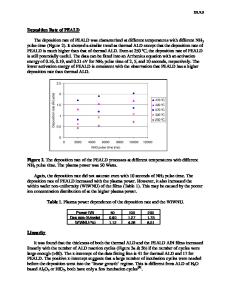Growth of Crystalline Superlattices of Aluminum Nitride/Zirconium Nitride on SI(111): Roughness and Layer Interruptions
- PDF / 2,037,899 Bytes
- 6 Pages / 420.48 x 639 pts Page_size
- 6 Downloads / 295 Views
GROWTH OF CRYSTALLINE SUPERLATTICES OF ALUMINUM NITRIDE/ZIRCONIUM NITRIDE ON SI(lll): ROUGHNESS AND LAYER INTERRUPTIONS W. J. Meng and J. Heremans
General Motors Research Laboratories, Warren, Michigan 48090
ABSTRACT We report on growth of crystalline superlattices of aluminum nitride/zirconium nitride on aluminum nitride buffered Si(lll) substrates. We observed increased buffer layer surface roughness as compared with the buffer/Substrate interface. This roughness in turn influences the quality of the superlattice. We report results of surface morphology examination as a function of growth rate and substrate temperature.
INTRODUCTION Metal nitride thin films have received much attention because of their interesting physical properties. They possess high melting temperatures (T,,), widely varying electrical properties from metallic to insulating, useful mechanical properties, and superconductivity[l]. Physical vapor deposition techniques are commonly used for synthesis of metal nitrides, among which reactive sputter deposition (RSD) enjoys the advantages of ease of operation and versatile choice of source materials and/or operating gases[2]. Because of the refractory nature of these compounds, growth often occurs at much reduced temperatures as compared to T,,. We recently reported epitaxial growth of aluminum nitride (AlN, insulating, Wurtzite, a=3.110A, c=4.975A, T,.=28000 C[3]) by RSD on Si(l11) at relatively low substrate temperatures (T. > 600°C)[4]. Using an AlN buffer layer, we have also grown, by RSD, epitaxial zirconium nitride (ZrN, metallic, NaCl, a=4.577A, Tm=2960°C[3]) and AlN/ZrN superlattices on Si(111)[5]. The superlattices were grown at 700°C, which is relatively low compared with Tm of both AIN and ZrN. We observed increased AIN buffer layer surface roughness as compared to the A1N/Si interface, also layer roughness and interruptions in A1N/ZrN superlattices[5]. In addition to observing these growth defects using transmission electron microscopy (TEM), we report here on the examination of surface morphology by reflection high energy electron diffraction (RHEED) as a function of growth rate and substrate temperature. EXPERIMENTAL Growth took place in an ultra-high-vacuum (UHV) chamber with base pressure - 2 x 10"• Torr. A separate chamber equipped with a RHEED system was connected with the main growth chamber and maintained at the same base pressure, in which RHEED examination of specimen surfaces at 10 keV post growth at room temperature was carried out. Details of the growth process was described elsewhere[5,6]. AlN/ZrN superlattices
Mat. Res. Soc. Symp. Proc. Vol. 237. @1992Materials Research Society
530
consisted of an equal number of alternating ZrN and AIN layers on an AlN buffer layer (.-.480A), with ZrN in contact with the buffer layer. Specimens were further examined by 0-20 x-ray diffraction, and TEM in both plan-view and cross-section. Details of TEM specimen preparation and imaging conditions were described elsewhere[5]. RESULTS AND DISCUSSION The epitaxial relationship between A
Data Loading...










